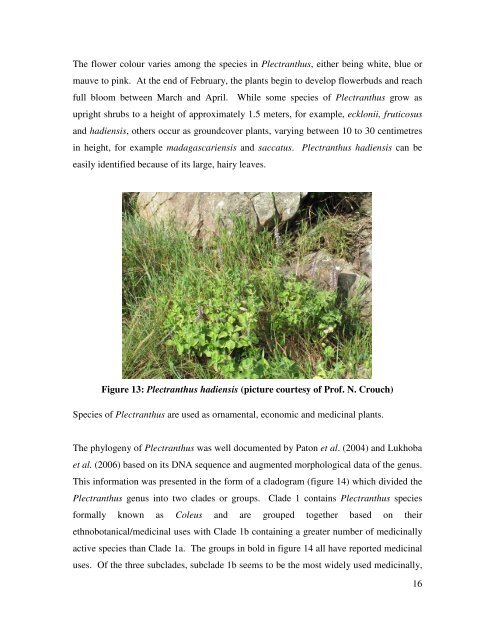university of kwazulu-natal faculty of science and agriculture school ...
university of kwazulu-natal faculty of science and agriculture school ...
university of kwazulu-natal faculty of science and agriculture school ...
You also want an ePaper? Increase the reach of your titles
YUMPU automatically turns print PDFs into web optimized ePapers that Google loves.
The flower colour varies among the species in Plectranthus, either being white, blue or<br />
mauve to pink. At the end <strong>of</strong> February, the plants begin to develop flowerbuds <strong>and</strong> reach<br />
full bloom between March <strong>and</strong> April. While some species <strong>of</strong> Plectranthus grow as<br />
upright shrubs to a height <strong>of</strong> approximately 1.5 meters, for example, ecklonii, fruticosus<br />
<strong>and</strong> hadiensis, others occur as groundcover plants, varying between 10 to 30 centimetres<br />
in height, for example madagascariensis <strong>and</strong> saccatus. Plectranthus hadiensis can be<br />
easily identified because <strong>of</strong> its large, hairy leaves.<br />
Figure 13: Plectranthus hadiensis (picture courtesy <strong>of</strong> Pr<strong>of</strong>. N. Crouch)<br />
Species <strong>of</strong> Plectranthus are used as ornamental, economic <strong>and</strong> medicinal plants.<br />
The phylogeny <strong>of</strong> Plectranthus was well documented by Paton et al. (2004) <strong>and</strong> Lukhoba<br />
et al. (2006) based on its DNA sequence <strong>and</strong> augmented morphological data <strong>of</strong> the genus.<br />
This information was presented in the form <strong>of</strong> a cladogram (figure 14) which divided the<br />
Plectranthus genus into two clades or groups. Clade 1 contains Plectranthus species<br />
formally known as Coleus <strong>and</strong> are grouped together based on their<br />
ethnobotanical/medicinal uses with Clade 1b containing a greater number <strong>of</strong> medicinally<br />
active species than Clade 1a. The groups in bold in figure 14 all have reported medicinal<br />
uses. Of the three subclades, subclade 1b seems to be the most widely used medicinally,<br />
16

















